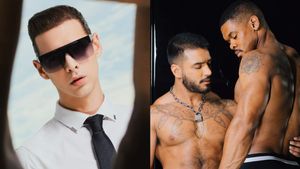A lot of people "know me" as a nice person in my public life, for being able to get along with even the people I vehemently disagree with. As a liberal commentator on Fox News for two years and now on CNN, I developed a reputation as a fierce progressive who is able to talk respectfully with conservatives, including extreme ones. I even gave a TED talk about how people with the most diametrically opposed views can practice what I call "emotional correctness" -- holding ourselves accountable for talking to each other with respect and finding empathy for one another, no matter how strongly we disagree.
Emotional correctness is about communicating compassion and mutual respect, not only with our words but with our intent and tone. I'm still an ardent fan, but I've been finding it increasingly difficult to practice, catching myself slipping into anger and swimming in hate. Especially in the last few years.
I was sort of trained to hate. Before I became a television commentator, I worked for fifteen years as a community organizer, fighting for policy reform on issues like lesbian, gay, bisexual, and transgender (LGBT) rights, health care, criminal justice, and immigration. Right-wingers were my enemies, and I hated them.
I still have friends, on the left as well as the right, who think that hate is one of the most useful tools in their civic-engagement tool belt. But when I became a commentator, I realized that I could have more influence if people would actually listen to me, which, practically speaking, they weren't going to do if they thought I hated them. Also, it turns out I prefer being liked, and if you want to be likable, it helps to like others.
But Donald Trump's election to the presidency of the United States of America made my blood boil. I couldn't believe the level of hate he so readily and proudly spewed -- against Muslims and women and immigrants and African Americans.
I remember feeling dumbfounded when George W. Bush was reelected in 2004; there was a map that my friends and I all shared over email that showed the United States carved up into blue parts and red parts, with the red parts labeled "Dumbfuckistan." I may not have consciously categorized Bush voters as less than human, but I certainly thought they were less than American and certainly less than me -- less smart, less understanding, and, ironically enough, less compassionate. I didn't think any of that was particularly hateful. I just thought I was correct.
But this was worse. I truly couldn't fathom that anywhere near a majority of my fellow Americans had voted for Donald Trump, and as much as I tried to pretend to be magnanimous and uniting, I hated them for it. Suddenly, all the partisan nastiness I'd tried to suppress or even solve as a talking head came rushing back to me with even more vengeance. Instead of being a prominent critic of incivility, I felt like I was auditioning to be the poster child for partisan hate. And though I knew this wasn't the first hateful moment in US history, or even the worst, it felt like the crisis that was bubbling up in me was also bubbling up throughout the United States and around the globe, in politics and pop culture, in sporting matches and mass shootings.
As I would catch myself in these little moments of hateful hypocrisy -- whether I was just noticing them more or they were getting worse -- I kept asking myself: If I could backslide into such anger so readily, was I really just a hateful person? Was all this stuff about niceness and emotional correctness an attempt to mask my true nature? Was it inevitable that the spreading crisis of hate would engulf not only me but all of us? I wanted to understand not only my own hate but the hate that seemed to be engulfing the planet. In writing my new book The Opposite of Hate: A Field Guide to Repairing Our Humanity, I set out to do just that.
The bad news is: we all hate. All of us. That includes me -- and I'm afraid it also includes you. I promise that although this is a book about hate, it will end on an uplifting and positive note. But we first have to face the hard truth. In different ways and to different degrees, consciously or unconsciously, all of us, in one way or another, sometimes treat other individuals and entire groups of human beings as though they are fundamentally less deserving than we are.
I am deliberately using a broad definition of "hate," one that's consistent with the definition used by many of the experts in the field -- from partisan incivility to overt sexism to implicit racial bias to any other tendency to discriminate against, dehumanize, or demean someone because of some aspect of who they are or the group to which they belong.
In fact, it's not only inaccurate but dangerous to reserve the term "hate" only for conscious and extreme forms of cruelty. What I've learned is that different forms and degrees of hate all stem from the same societal and psychological phenomena, which divide communities against each other and dehumanize groups of "others," creating a climate in which further hate becomes more likely and even, potentially, deadly. "We are all potential dehumanizers, just as we are all potential objects of dehumanization," writes philosopher David Livingstone Smith. I wanted to understand not only how these different kinds and degrees of hate are related but how we can stop small hates from growing out of control.
The United States was founded on hate -- the hatred that justified colonial annihilation of American Indians and that perpetuated the enslavement of Africans. Hate divided the country during the Civil War and, a century later, spawned protest movements and backlash movements, with activists vying over issues of justice and human rights. And Americans are not alone in this legacy. Obviously, our globe's history of colonial conquest and brutality, and the many current hot spots of extreme violence and displacement, reflect deep currents of hate. It would be naive to argue we're in the most hateful moment in history. But relativity on this topic is cold comfort. The hate that's brewing now is harmful, frightening, and increasingly acute. It doesn't have to be the worst moment in history for it to be bad enough to warrant a concerted effort at reckoning -- and change.
In the twenty-five years the Pew Research Center has surveyed Republicans and Democrats about how they view the other party, the majority of respondents in both parties answered "very unfavorable" for the first time in 2016. "More than half of Democrats (55%) say the Republican Party makes them 'afraid,' while 49% of Republicans say the same about the Democratic Party," the poll found. And just under half of the members of both parties say that the other party makes them feel "angry."
We talk about politics and political engagement in aggressive, apocalyptic terms. Republicans are launching a "War on Women." Democrats are launching a "War on Christmas." Immigrants are "invading." During the 2016 election, Donald Trump and his supporters repeatedly chanted, "Lock her up!" regarding Hillary Clinton. And at one rally I attended, a Trump supporter shouted, "Hang her in the streets!"
Our problem with hate is not only a matter of speech or sentiment. Since the 2016 election, the United States has seen a rise in attacks on Muslims and immigrants and Jewish communities. Hate crimes in the US increased by 20 percent in 2016, fueled in part by the contentious election. In the first three months of 2017 alone, anti-Semitic incidents rose by 86 percent. In January 2017, swastikas were drawn on three synagogues in the town of Clearwater, Florida. In June 2017, a teenage Muslim girl wearing a hijab and an abaya was murdered with a baseball bat, then dumped in a pond. Later, a memorial to the girl was burned. In February 2017, four black teenagers were charged with hate crimes after they kidnapped a white teenager with a mental disability and broadcast a livestream on Facebook Live as they beat the man and yelled,
"Fuck white people!" White supremacists, rebranded as the "alt-right," have become more visible and emboldened -- not to mention empowered -- including high-level alt-righters given posts in the Trump White House.
Hate is also coming from the other side of the political spectrum. As I was writing this book in June 2017, an avowed liberal who had volunteered for Bernie Sanders's presidential campaign opened fire on Republican members of Congress practicing for an annual bipartisan baseball game. He allegedly wanted to kill conservatives. When a wildfire destroyed one thousand homes in Gatlinburg, Tennessee, in November 2016, killing fourteen people and injuring two hundred others, one Trump opponent tweeted, "Laughing at all the Trump supporters in Gatlinburg as their homes burn to the ground tonight. Too bad it's not the whole state burning," and another tweeted, "Maybe it's 'god' punishing them for voting for Trump."
Much of the media relies on making animosity not only palatable but virtually addictive. More and more of us get our news primarily, if not exclusively, from television channels and websites that cater to our hate and present information in ways that reinforce our biases. This not only exploits hate but exacerbates it. And sure, we can blame Donald Trump for bringing open hatred once again into the top ranks of visible political power, but hate has been coursing through the veins of our society since English colonizers set foot on North America's shores, and it has been aided and abetted by elected leaders and judges and bankers and textbooks and TV shows.
So what do we do now?
Fight back. We need to realize that the animosity and otherizing gripping American politics and public life right now is neither inevitable nor unavoidable. And just because we have committed versions of it throughout history doesn't mean we have no choice but to keep hating now. Indeed, the silver lining of United States history has been our perpetual ability to improve on our ugly past, however gradually. Just like we stopped treating Irish and Italian immigrants as garbage, we can stop demeaning Muslims and Mexicans. Just like we stopped hating the British, we can stop hating each other.
Too often, we begrudgingly accept hate, or even cheer it on. Too often, we don't see the hate around us. Too often, we don't see it in ourselves. Too often, people in our communities and around the world are beaten down by hate that we consciously or unconsciously spread. Now is as nice a time as any to stop -- before it gets even worse.
Adapted from The Opposite of Hate: A Field Guide to Repairing Our Humanity by Sally Kohn (c) 2018 by Sally Kohn. Reprinted by permission of Algonquin Books of Chapel Hill. All rights reserved.
SALLY KOHN is a CNN political commentator, activist and the author of The Opposite of Hate: A Field Guide to Repairing Our Humanity (Algonquin Books; April 10, 2018). She is also the host of the State of Resistance podcast.




































































Charlie Kirk DID say stoning gay people was the 'perfect law' — and these other heinous quotes